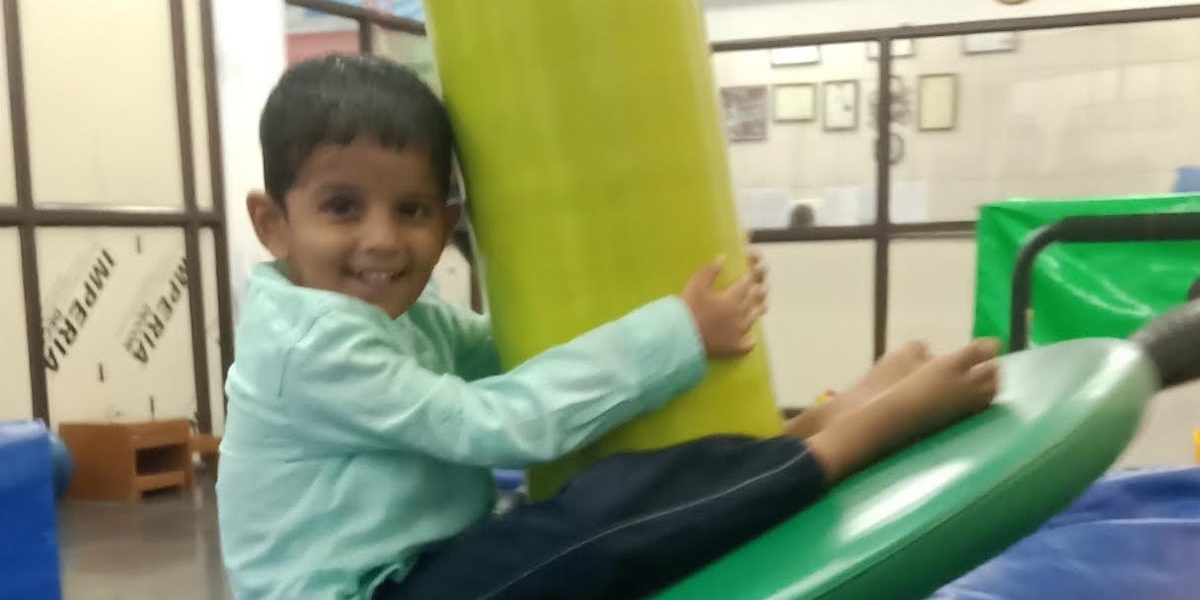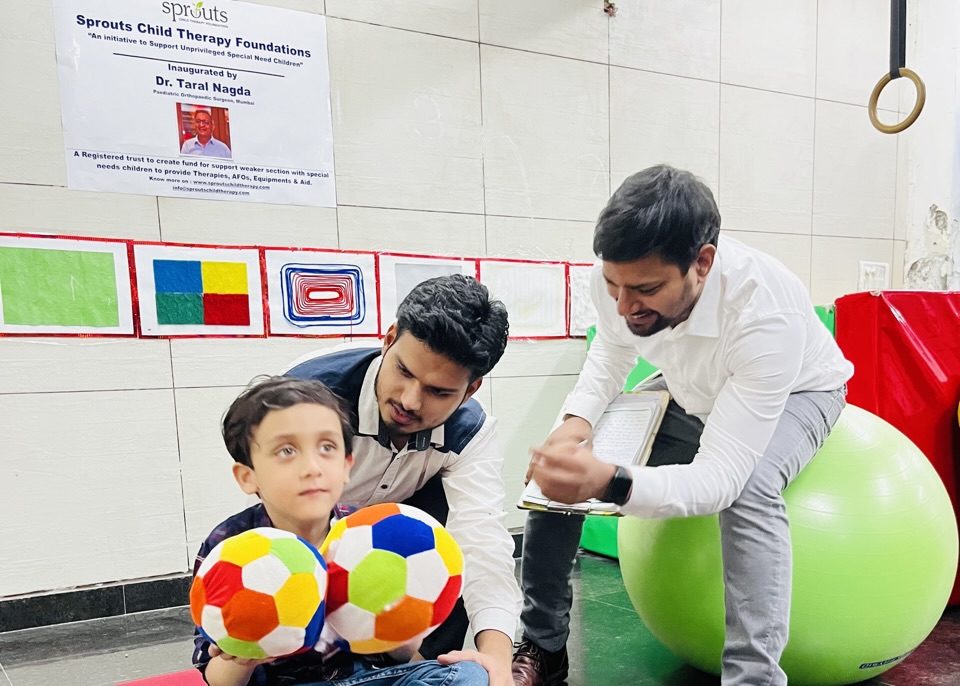Occupational Therapy

SENSORY INTEGRATION THERAPY Creating possibilities
THE IMPORTANCE OF SENSORY INTEGRATION THERAPY
WHAT IS SENSORY INTEGRATION THERAPY?
Ayres Sensory Integration® Therapy is a therapy designed to help children with sensory processing difficulties such as sensory processing disorder and sensory modulation disorder, improve their ability to process sensory input. It makes sensory-rich day to day environments less disturbing and increases a child’s threshold for tolerating these environments.
The sensory system takes information from the surrounding environment and experiences including touch, movement, body awareness, sight, sound, smell, taste and the pull of gravity. The process of the brain organising and interpreting this information is called Sensory Integration, providing a crucial foundation for more complex learning and behaviour as children grow and evolve.
Sensory Integration is the term used to describe the way in which the brain sorts out and organises the many sensations which we receive and use every day and is the body’s ability to:
- Receive or take in sensory stimuli
- Interpret the stimuli
- Process the stimuli into a response
- Adaptively respond to the stimuli
For most children, sensory integration develops throughout the course of ordinary childhood activities. Motor planning – remembering and performing steps to make a movement happen, is a natural outcome of this process, as is the ability to adapt to incoming sensations. But, for some children, sensory integration does not develop as efficiently and seamlessly as it should.
When this process is disordered, a number of problems in learning, development and behaviour may become evident. This puts children with sensory issues at high risk for many emotional, social, and educational problems, including the inability to make friends or be a part of a group, poor self-concept, academic failure, and being labelled clumsy, uncooperative, belligerent, disruptive, or “out of control.” Anxiety, depression, aggression, or other behavioural problems can follow.
Not all children with learning, developmental or behavioural problems have underlying sensory integration difficulties.
DELAYS IN SPEECH, LANGUAGE, MOTOR SKILLS, OR ACADEMIC ACHIEVEMENT
These may be evident in a pre-schooler along with other signs of poor sensory integration. In a school-aged child, there may be problems in some academic areas despite normal intelligence.
POOR ORGANISATION OF BEHAVIOUR
Some children may be impulsive or distractible and show a lack of planning in approach to tasks. They may have difficulty adjusting to new situations, others may react to circumstances with frustration, aggression, or withdrawal when they encounter failure.
OVERLY SENSITIVE TO TOUCH, MOVEMENT, SIGHTS, SMELLS, TASTES AND SOUNDS
This may be manifested in behaviours such as irritability or withdrawal when touched, avoidance of certain textures of clothes or food, easily distracted as well as fearful reactions to ordinary movement activities such as swinging and spinning.
UNDER-REACTIVE TO SENSORY STIMULATION
An under responsive child may seek out sensory experiences such as whirling in circles or crashing into people and objects. Children may seem oblivious to pain or to body position. Some children fluctuate between extremes of over and under responsiveness.
ACTIVITY LEVELS THAT ARE UNUSUALLY HIGH OR LOW
Children may be constantly on the move or the opposite, very slow to warm up and fatigue easily and again, may fluctuate between extremes
COORDINATION PROBLEMS
Some children may have unusually poor balance, while others have great difficulty learning to do a new task that requires motor coordination, which can be seen in gross and fine motor activities.
POOR SELF-CONCEPT
Often a child with sensory processing difficulties ‘does not quite feel right.’ A bright child may know that some tasks are more difficult than others but may not know why. This can sometimes come across as bored, lazy or unmotivated, with children developing strategies to avoid tasks that are hard or embarrassing. When this happens, the child may be considered troublesome or stubborn, prior to addressing the real problem at hand.
Look at what the behaviour is trying to tell you, rather than looking at the behaviour as being negative or ‘bad’
Sensory Modulation Disorder
1. SENSORY MODULATION DISORDER
Children with Sensory Modulation Disorder (difficulties) experience their world as being Hypersensitive (over reactive) and avoid sensation. For some, they can experience the opposite, being Hyposensitive (under reactive) and actively seek sensation. For some, they experience a mix of both and the degree to which this impacts on their functioning can vary from one day to the next. Children may react with strong emotional behaviours and experience what may be better described as ‘melt downs.’
WHAT ARE THE SENSORY MODULATION DISORDER BEHAVIOURS?
- Avoids messy materials in play like playdough, glue, paint and sand
- Dislikes the feeling of certain clothing
- Dislikes standing in line and unexpected touch or touch in general
- Doesn’t register pain as others do (For example: doesn’t notice bleeding until mentioned by others)
- Easily visually distracted
- Overwhelmed in visually stimulating environments like shopping malls and supermarkets
- Often misses part or all of verbal instructions given
- Fearful of noises that don’t bother others such as planes, the vacuum cleaner, hair dryers and sirens
- Distracted by noises not noticed by others
Distressed by smells not distressing to others like perfume or cleaning products
- Constantly mouths non-food objects like their sweaters and toys
- Very picky eater usually texture based
- History of poor feeding or irregular hunger patterns
- Hesitates to climb or play with equipment that moves
- Seeks out spinning and jumping a lot
- Becomes motion sick easily
- Clumsy, accident-prone, bumps into people and things
- Lacks co-ordination
- Dislike being in crowded places
- Difficulty accepting change in routine
- Lacks organisation in tasks
- Appears to know what they want to do, but can’t “get it together”
- Rapid and extreme mood and activity level changes
- Difficulty calming after exciting activity and fidgets a lot
- Difficulty getting to sleep or staying asleep along with irregular sleep or hunger patterns
- Finds excuses to wander during seated time at school or dinner the table
- Day dreamy, hard to motivate
- Difficulty sustaining concentration
The brain and nervous system must act as a filter, filtering in and filtering out sensory input from the environment to achieve the optimal level of arousal in order to attend to the task at hand or simply remain in a state of equilibrium. Difficulties with sensory modulation often make achieving this state of equilibrium very difficult.
Sensory modulation disorder is apparent when children present motor skill problems and sensory processing difficulties. The brain and nervous system receive input from body parts as well as from the outside world. The central nervous system is also a means of transmitting messages throughout the body and functions somewhat like a computer system. The messages that are transmitted, however, affect functions such as muscle movement, coordination, learning, memory, emotion, behaviour and thought. As with a computer, a breakdown or malfunction in one part of the system often affects other functions of the system.
Sensations from hearing, vision, taste, smell, touch, pressure, and movement provide the input to the brain which is organized for movement, cognition and learning. The richness of the sensory environment and the interactive experience of the individual with the environment contribute to children’s optimal development.
Sensory Processing Disorder
2. SENSORY PROCESSING DISORDER (EXPRESSIONS OF DYSPRAXIA)
When children have a Sensory Processing Disorder, there exists a theory that the brain does not process or organise the flow of sensory impulses in a way that gives the child precise information about themselves and their world.
WHAT ARE THE SENSORY PROCESSING DISORDER BEHAVIOURS?
- Clumsy, trips often, bumps into people and things, knocks things over
- Slumped posture when sitting at the table
- Walk on toes
- Can’t sit or stand still, fidgets a lot
- Dislikes using playground equipment and physical education lessons
- Difficulty catching, throwing and kicking balls
- Awkward pencil grip
- Presses too hard when writing and breaks the pencil lead often
- Poor tracing, writing, cutting and pasting skills
- Swaps dominant hands when performing tasks
- Doesn’t use the non-dominant hand to assist in activities, for example doesn’t stabilise the paper when writing
- Trouble handling small objects
- Slow in completing set tasks
- Difficulty opening school lunch boxes and other containers
- Difficulty tying shoelaces
- Takes a long time to complete basic self-care tasks
- Trouble orienting clothes properly when getting dressed
- Trouble doing up fastenings when dressing like buttons, zips and press studs
- Messy eater
- Attempts to control and direct play with peers, coming across very rude
- Tends to play the same game repeatedly rather than try new activities
- Has trouble staying with one toy or activity for long
- Prefers play with older or younger children than age peers
- Plays beside rather than with peers
LEARNING SOCIAL AND EMOTIONAL BEHAVIOURS
- Fearful of new situations
- Lacks confidence
- Disorganised and messy
- Has difficulty accepting change in routine with ease
- Becomes easily frustrated
- Short attention span, often impulsive
- Difficulty starting or completing assignments
- Difficulty planning and sequencing tasks
- Difficulty copying from the blackboard
- Easily loses place when reading or writing
Sensory Integration Therapy
RESEARCH INTO SENSORY INTEGRATION THERAPY
Research in Sensory Integration Therapy has increased considerably over the last few decades and is researched not only by Occupational Therapists but also by other health professionals and academics.
Sensory Integration Therapy has clearly provided great discussion amongst peers, academics, researchers and other health professionals. The formation of the International Council for Education in Ayres Sensory Integration® (ICEASI®) alongside the Ayres SI 2020 Vision sparked a resurgence in evidence-based research over the last 15 years that has created numerous research articles focusing on the effectiveness of Ayres SI. Further information regarding SI research is available via Research and Literature in Sensory Integration
# occupational therapy centre near me # occupational therapy for kids # occupational therapy centre # occupational therapy online # best occupational therapist in Grugram # occupational therapy for autism near me # best occupational therapist in haryana # best occupational therapist in delhi # speech & language pathology speech therapy for kids # speech therapist for kids near me # aba therapy # aba therapy near me # aba therapy for autism # child psychologist near me # best child psychologist near me # online child psychologist # special education centers # special education therapist # autism therapy # autism therapy centre in grugram # autism therapy center

